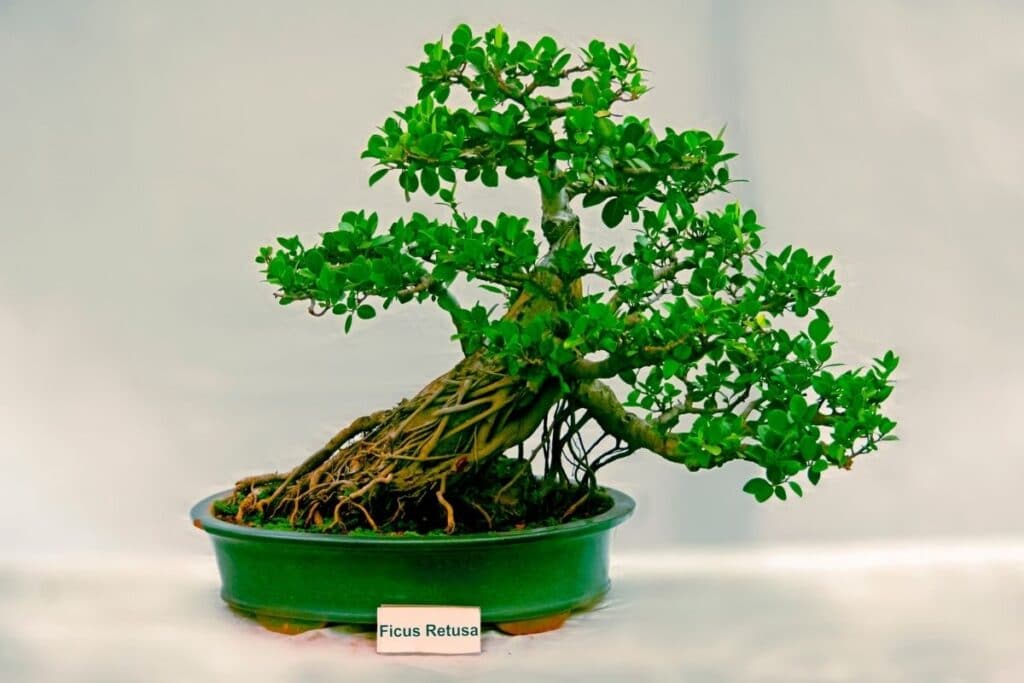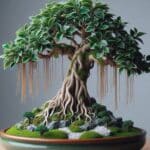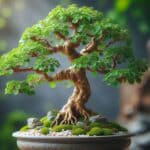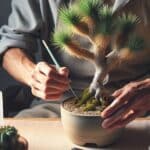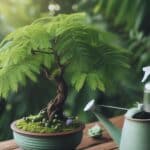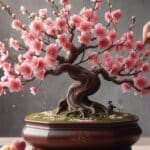With elegant, exquisite s-curved trunks and dark green oval leaves, Ficus retusa is a classic bonsai choice. It’s one of up to 2000 different ficus tree species used for bonsai. A hardy and reliable grower, it is the perfect specimen for beginners and experts alike.
Often grafted with Ficus microcarpa, Ficus retusa is often grown indoors but can occasionally be grown bonsai outdoors as well.
Here are tips on how to grow this unique and attractive bonsai tree for your personal oasis.
Interesting Facts about Ficus Retusa Bonsai
| Height | 10-12” |
| Width | 8-10” |
| Sunlight | Full sun |
| Flowering Time Length | N/A |
| Lifespan | 100+ years |
| Scientific Name | Ficus retusa |
Growing Ficus Retusa Bonsai from Seed or by Propagation
You can grow your ficus retusa both from seed or by propagation. There are several ways to do this, but if you choose to plant from seed, wait until spring.
When planting cuttings, use mid summer growth for semi-hardwood cuttings. You can also use the air layering technique in the early spring, ideally in April or May.
How to Care for Ficus Retusa Bonsai
Sunlight
Although Ficus retusa is undoubtedly beautiful to look at, it’s not the hardiest bonsai tree species you will find.
Because they are native to tropical climates, it does not do well with colder weather. It is primarily grown as an indoor bonsai tree.
You can keep your ficus trees outside in the summer if you choose, but only if temperatures remain above 60 degrees Fahrenheit. Dry air and not enough light result in leaf drop that kill your plants.
Put your tree in a sunny location. It does not tolerate shade.
Watering
Although these tree species can tolerate some dry soil and low humidity, since it has thick and waxy leaves, it prefers higher levels of humidity. The better you are at providing this tree with the humidity it needs, the more likely it will be to develop strong aerial roots.
Spritzing your ficus bonsai with a bit of water in a spray bottle every day is a great idea. You should also water liberally whenever the soil is dry. If you can, use water that is somewhat soft and at room temperature.
Avoid misting more often than once a day, as this can create fungal problems, but know that the warmer the conditions happen to be, the more water your ficus tree will be. During the winter, you may be able to get by with less frequent misting and watering.
Fertilizing
In the summer, when your Ficus retusa bonsai tree is actively growing, you should fertilize every other week. You can drop down to once per month in the winter but fertilizer even less frequently if growth has stopped. You can use a general all-purpose fertilizer for bonsai plants.
Potting and Repotting
Repot and root pruning are essential for your Ficus retusa bonsai every other year, ideally in the spring and by using a basic bonsai mixture.You can root prune at this time but avoid removing more than a third of the plant.
Pruning Ficus Retusa Bonsai
Like many bonsai ficus species, the more adeptly you prune your Ficus retusa bonsai, the better. This will help it retain its shape. You can prune back to two leaves after six to eight have grown or you can completely defoliate the tree to reduce its leaf size – this bonsai species is known for producing exceptionally large leaves.
If you want the trunk to develop more, you can let it grow without pruning for a year or two.
You may also choose to wire the thinner branches of your ficus bonsai tree. Check them regularly to make sure they aren’t cutting into the bark.
Pests and Diseases
Ficus retusa and other plants in the fig family tend to be quite resistant to most diseases and pests, but they can still fall victim to the occasional indoor pest, like scale or spider mites. Watch for these pests in the winter, when dry air and poor lighting make your plants more vulnerable. You can use a grow light or heat lamp to help improve conditions and mist the leaves to reduce the likelihood of infestation, too.
Where to Buy Ficus Retusa Bonsai
Because it is one of the most popular bonsai species, you can buy Ficus retusa bonsai trees at just about any home improvement store or nursery. Be aware that many mass produced bonsai are coupled with all kidneys of problems, such as poorly grafted branches, so purchasing your plant from a specialized bonsai supply store may be more desirable for a plant that is healthier overall.
FAQs
Do Ficus bonsai trees need direct sunlight?
Ficus bonsai, including Ficus retusa, prefer bright, indirect sunlight. While they can tolerate some direct sunlight, especially during the morning or late afternoon, prolonged exposure to intense sunlight can cause leaf burn or scorching.
What temperature is good for Ficus retusa bonsai?
Ficus retusa bonsai thrive in temperatures between 65°F to 75°F (18°C to 24°C) during the day and slightly cooler temperatures at night. Avoid exposing them to extreme temperature fluctuations, drafts, or cold drafts, as this can stress the bonsai plant.
Why are the leaves on my Ficus retusa bonsai tree turning brown?
Several factors can cause the leaves on a Ficus retusa bonsai tree to turn brown, including underwatering, overwatering, low humidity, inadequate light, or sudden changes in environmental conditions. Assess the plant’s care regimen and growing conditions to identify and address the specific issue causing leaf browning. Adjust watering, lighting, and humidity levels accordingly to promote healthy foliage.
Final thoughts
In conclusion, Retusa Ficus bonsai care requires a lot of attention and care.
With patience and commitment, bonsai enthusiasts can cultivate stunning Ficus retusa bonsai that serve as captivating works of living art in their collections.
See more: Ficus Microcarpa Ginseng Bonsai
*image by yogesh_more/depositphotos

